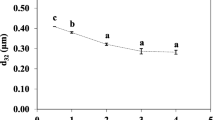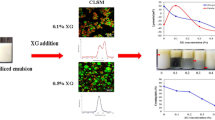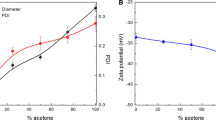Abstract
The paper discusses the formation, stability, surface and rheological characteristics, as well as in vitro behavior in the gastrointestinal tract of magnetite/cellulose nanocrystals (MCNC)-stabilized olive oil-in-water Pickering emulsions. It has been shown that MCNC-stabilized olive oil-in-water emulsions with a mass percentage of magnetite in the composite of 37–83% are the most resistant to delamination during storage. An increase in the number of acid–base centers is observed for hybrid particles on the oil surface due to their orientation and the formation of a 2D structure. The dynamic viscosity and thixotropic properties of emulsions increase as the zeta potential of drops approaches zero. The stability of emulsions in vitro in oral and gastric phases of gastrointestinal tract and destruction in the medium of the small intestine has been shown. The resulting emulsions can be promising in various biomedical applications due to their high stability, magnetic control, and low toxicity.
Graphical Abstract









Similar content being viewed by others
References
Zhao H, Li J, Wang L, Li C, Zhang S (2021) Pickering emulsion stabilized by dual stabilizer: a novel reaction/separation system for methacrolein synthesis. Chem Eng Sci 229:116038. https://doi.org/10.1016/j.ces.2020.116038
Ozturk B, Argin S, Ozilgen M, McClements DJ (2015) Nanoemulsion delivery systems for oil-soluble vitamins: influence of carrier oil type on lipid digestion and vitamin D3 bioaccessibility. Food Chem 187:499–506. https://doi.org/10.1016/j.foodchem.2015.04.065
Surjit Singh CK, Lim H-P, Tey B-T, Chan E-S (2021) Spray-dried alginate-coated Pickering emulsion stabilized by chitosan for improved oxidative stability and in vitro release profile. Carbohydr Polym 251:117110. https://doi.org/10.1016/j.carbpol.2020.117110
Bao C, Chen X, Liu C, Liao Y, Huang Y, Hao L, Yan H, Lin Q (2021) Extraction of cellulose nanocrystals from microcrystalline cellulose for the stabilization of cetyltrimethylammonium bromide-enhanced Pickering emulsions. Colloids Surfaces A Physicochem Eng Asp 608:125442. https://doi.org/10.1016/j.colsurfa.2020.125442
Torlopov MA, Vaseneva IN, Mikhaylov VI, Martakov IS, Moskalev AA, Koval LA, Zemskaya NV, Paderin NM, Sitnikov PA (2021) Pickering emulsions stabilized by partially acetylated cellulose nanocrystals for oral administration: oils effect and in vivo toxicity. Cellulose 28:2365–2385. https://doi.org/10.1007/s10570-021-03690-4
Madhavan N, Mukherjee M, Basavaraj MG (2020) Porous ceramics via processable Pickering emulsion stabilized by oppositely charged colloids. Langmuir 36:11645–11654. https://doi.org/10.1021/acs.langmuir.0c02339
Wang J, Yu M, Yang C (2019) Colloidal TiO2 nanoparticles with near-neutral wettability: an efficient Pickering emulsifier. Colloids Surfaces A Physicochem Eng Asp 570:224–232. https://doi.org/10.1016/j.colsurfa.2019.03.035
Zhai X, Gao J, Wang X, Mei S, Zhao R, Wu Y, Hao C, Yang J, Liu Y (2018) Inverse Pickering emulsions stabilized by carbon quantum dots: influencing factors and their application as templates. Chem Eng J 345:209–220. https://doi.org/10.1016/j.cej.2018.03.075
Sun N, Li Q, Luo D, Sui P, Jiang Q, Liu J, Li A, Si W, Ma Y (2021) Dual-responsive Pickering emulsion stabilized by Fe3O4 nanoparticles hydrophobized in situ with an electrochemical active molecule. Colloids Surfaces A Physicochem Eng Asp 608:125588. https://doi.org/10.1016/j.colsurfa.2020.125588
Qi W, Li T, Zhang Z, Wu T (2021) Preparation and characterization of oleogel-in-water pickering emulsions stabilized by cellulose nanocrystals. Food Hydrocoll 110:106206. https://doi.org/10.1016/j.foodhyd.2020.106206
Dai H, Wu J, Zhang H, Chen Y, Ma L, Huang H, Huang Y, Zhang Y (2020) Recent advances on cellulose nanocrystals for Pickering emulsions: development and challenge. Trends Food Sci Technol 102:16–29. https://doi.org/10.1016/j.tifs.2020.05.016
Zhang X, Ren S, Han T, Hua M, He S (2018) New organic–inorganic hybrid polymers as Pickering emulsion stabilizers. Colloids Surfaces A Physicochem Eng Asp 542:42–51. https://doi.org/10.1016/j.colsurfa.2018.01.034
Mikhaylov VI, Torlopov MA, Vaseneva IN, Sitnikov PA (2021) Magnetically controlled liquid paraffin oil-in-water Pickering emulsion stabilized by magnetite/cellulose nanocrystals: formation and Cr(VI) adsorption. Colloids Surfaces A Physicochem Eng Asp 622:126634. https://doi.org/10.1016/j.colsurfa.2021.126634
Low LE, Tey BT, Ong BH, Chan ES, Tang SY (2017) Palm olein-in-water Pickering emulsion stabilized by Fe3O4-cellulose nanocrystal nanocomposites and their responses to pH. Carbohydr Polym 155:391–399. https://doi.org/10.1016/j.carbpol.2016.08.091
Low LE, Tey BT, Ong BH, Tang SY (2018) Unravelling pH-responsive behaviour of Fe3O4@CNCs-stabilized Pickering emulsions under the influence of magnetic field. Polymer (Guildf) 141:93–101. https://doi.org/10.1016/j.polymer.2018.03.001
Low LE, Tan LT-H, Goh B-H, Tey BT, Ong BH, Tang SY (2019) Magnetic cellulose nanocrystal stabilized Pickering emulsions for enhanced bioactive release and human colon cancer therapy. Int J Biol Macromol 127:76–84. https://doi.org/10.1016/j.ijbiomac.2019.01.037
Low LE, Ong BH, Tey BT, Tang SY (2020) Factors affecting the stability and physical properties of pickering emulsions stabilized by Fe3O4@CNC nanocomposites. Prog Drug Discov Biomed Sci 3(1):a0000073. https://doi.org/10.3687/pddbs.a0000073
McClements DJ (2015) Food Emulsions. CRC Press. https://doi.org/10.1201/b18868
Zhu X, Chen J, Hu Y, Zhang N, Fu Y, Chen X (2021) Tuning complexation of carboxymethyl cellulose/ cationic chitosan to stabilize Pickering emulsion for curcumin encapsulation. Food Hydrocoll 110:106135. https://doi.org/10.1016/j.foodhyd.2020.106135
Owen RW, Giacosa A, Hull WE, Haubner R, Würtele G, Spiegelhalder B, Bartsch H (2000) Olive-oil consumption and health: the possible role of antioxidants. Lancet Oncol 1:107–112. https://doi.org/10.1016/S1470-2045(00)00015-2
Yan H, Chen X, Song H, Li J, Feng Y, Shi Z, Wang X, Lin Q (2017) Synthesis of bacterial cellulose and bacterial cellulose nanocrystals for their applications in the stabilization of olive oil pickering emulsion. Food Hydrocoll 72:127–135. https://doi.org/10.1016/j.foodhyd.2017.05.044
Torlopov MA, Mikhaylov VI, Udoratina EV, Aleshina LA, Prusskii AI, Tsvetkov NV, Krivoshapkin PV (2018) Cellulose nanocrystals with different length-to-diameter ratios extracted from various plants using novel system acetic acid/phosphotungstic acid/octanol-1. Cellulose 25:1031–1046. https://doi.org/10.1007/s10570-017-1624-z
Drozdov AS, Ivanovski V, Avnir D, Vinogradov VV (2016) A universal magnetic ferrofluid: nanomagnetite stable hydrosol with no added dispersants and at neutral pH. J Colloid Interface Sci 468:307–312. https://doi.org/10.1016/j.jcis.2016.01.061
Winuprasith T, Khomein P, Mitbumrung W, Suphantharika M, Nitithamyong A, McClements DJ (2018) Encapsulation of vitamin D3 in pickering emulsions stabilized by nanofibrillated mangosteen cellulose: impact on in vitro digestion and bioaccessibility. Food Hydrocoll 83:153–164. https://doi.org/10.1016/j.foodhyd.2018.04.047
Bai L, Lv S, Xiang W, Huan S, McClements DJ, Rojas OJ (2019) Oil-in-water Pickering emulsions via microfluidization with cellulose nanocrystals: 2. In vitro lipid digestion, Food Hydrocoll 96:709–716. https://doi.org/10.1016/j.foodhyd.2019.04.039
Mikhaylov VI, Kryuchkova AV, Sitnikov PA, Koval LA, Zemskaya NV, Krivoshapkina EF, Krivoshapkin PV (2020) Magnetite hydrosols with positive and negative surface charge of nanoparticles: stability and effect on the lifespan of Drosophila melanogaster. Langmuir 36:4405–4415. https://doi.org/10.1021/acs.langmuir.0c00605
Tracey CT, Torlopov MA, Martakov IS, Vdovichenko EA, Zhukov M, Krivoshapkin PV, Mikhaylov VI, Krivoshapkina EF (2020) Hybrid cellulose nanocrystal/magnetite glucose biosensors. Carbohydr Polym 247:116704. https://doi.org/10.1016/j.carbpol.2020.116704
Yang Y, Fang Z, Chen X, Zhang W, Xie Y, Chen Y, Liu Z, Yuan W (2017) An overview of pickering emulsions: solid-particle materials, classification, morphology, and applications. Front Pharmacol 8:287. https://doi.org/10.3389/fphar.2017.00287
Kim I, Worthen AJ, Johnston KP, DiCarlo DA, Huh C (2016) Size-dependent properties of silica nanoparticles for Pickering stabilization of emulsions and foams. J Nanoparticle Res 18:82. https://doi.org/10.1007/s11051-016-3395-0
Zou S, Wang C, Gao Q, Tong Z (2013) Surfactant-free multiple pickering emulsions stabilized by combining hydrophobic and hydrophilic nanoparticles. J Dispers Sci Technol 34:173–181. https://doi.org/10.1080/01932691.2012.657947
Chen X, McClements DJ, Wang J, Zou L, Deng S, Liu W, Yan C, Zhu Y, Cheng C, Liu C (2018) Coencapsulation of (−)-epigallocatechin-3-gallate and quercetin in particle-stabilized W/O/W emulsion gels: controlled release and bioaccessibility. J Agric Food Chem 66:3691–3699. https://doi.org/10.1021/acs.jafc.7b05161
Low LE, Siva SP, Ho YK, Chan ES, Tey BT (2020) Recent advances of characterization techniques for the formation, physical properties and stability of Pickering emulsion. Adv Colloid Interface Sci 277:102117. https://doi.org/10.1016/j.cis.2020.102117
Mikhailov VI, Torlopov MA, Martakov IS, Krivoshapkin PV (2017) Stability of nanocrystalline cellulose in aqueous KCl solutions. Colloid J 79:226–233. https://doi.org/10.1134/S1061933X17020065
Ryazanov MA, Dudkin BN (2009) Acid-base properties of the surface of the α-Al2O3 suspension. Russ J Phys Chem A 83:2318–2321. https://doi.org/10.1134/S0036024409130238
Cren ÉC, Morelli AC, Sanches T, Rodrigues CE, Meirelles AJA (2010) Adsorption isotherms for removal of linoleic acid from ethanolic solutions using the strong anion exchange resin Amberlyst A26 OH. J Chem Eng Data 55:2563–2566. https://doi.org/10.1021/je900808z
Pal R (2017) A simple model for the viscosity of Pickering emulsions. Fluids 3:2. https://doi.org/10.3390/fluids3010002
Katepalli H, John VT, Tripathi A, Bose A (2017) Microstructure and rheology of particle stabilized emulsions: effects of particle shape and inter-particle interactions. J Colloid Interface Sci 485:11–17. https://doi.org/10.1016/j.jcis.2016.09.015
Funding
The reported study was supported by a Grant of the Russian Science Foundation No. 19–73-10091. Investigations were partially carried out using the equipment of the “Khimiya” Common Use Centre (Institute of Chemistry, FRC Komi SC UB RAS).
Author information
Authors and Affiliations
Contributions
VIM: conceptualization, methodology, funding acquisition, project administration, visualization, investigation, and writing—original draft. MAT: conceptualization, methodology, investigation, and writing—original draft. INV: investigation, methodology, and writing—review and editing. ISM: investigation, methodology, and writing—review and editing. PVL: investigation, methodology, and writing—original draft. PAS: supervision, investigation, and writing—original draft.
Corresponding author
Ethics declarations
Conflict of interest
There authors declare no competing interests.
Additional information
Publisher's Note
Springer Nature remains neutral with regard to jurisdictional claims in published maps and institutional affiliations.
Supplementary Information
Below is the link to the electronic supplementary material.
Rights and permissions
About this article
Cite this article
Mikhaylov, V.I., Torlopov, M.A., Vaseneva, I.N. et al. Effect of Fe3O4/CNC ratio on properties of olive oil-in-water Pickering emulsions. Colloid Polym Sci 300, 139–152 (2022). https://doi.org/10.1007/s00396-021-04938-y
Received:
Revised:
Accepted:
Published:
Issue Date:
DOI: https://doi.org/10.1007/s00396-021-04938-y




